Chrysler Corporation in the ’70s was a lot of peaks and valleys. As the ’80s approached and downsizing took hold at GM, Chrysler seemed headed for the junkyard thanks to gross incompetence, lack of money and lack of consumer confidence. They needed new, downsized big cars, but lacked money to develop and build them. Taking a page from GM’s use of the Colonnade as the platform for the new ’77 Caprice, Chrysler used the midsize Fury/Monaco chassis for the 1979 full-sizers, with Broughamtastic new sheetmetal and interior aping the ’76 Seville/’77 B- and C-body ‘sheer’ look. Unfortunately for Chrysler, and unlike GM, it didn’t translate to runaway sales success.
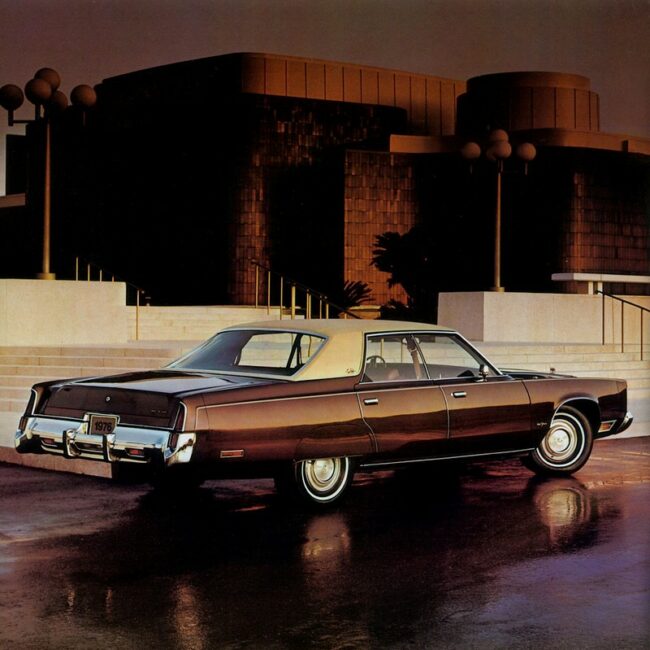
Along with Lincoln, Chrysler was a stubborn holdout when it came to downsizing. Even so, they knew that the 1978 New Yorker Brougham and Newport, while big and plush, were dated. With baroque styling and pillarless roofs, they seemed well behind the times next to fresh models like Chevrolet’s Malibu and Caprice–not to mention Chrysler’s own Diplomat and LeBaron models. But with no money available, what could be done?
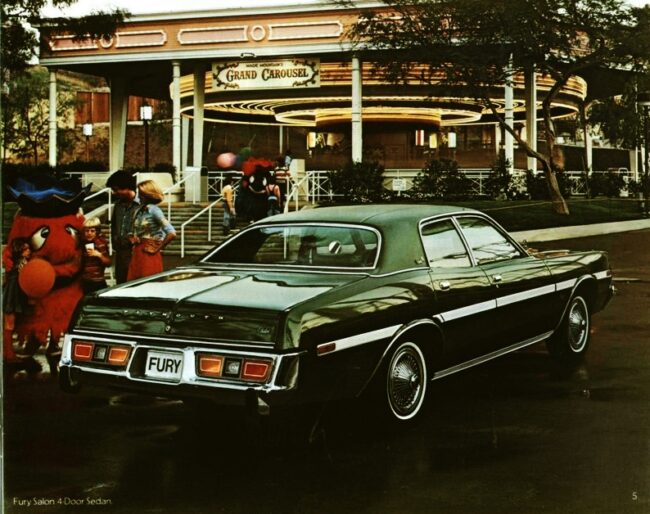
Enter the B-body. Introduced in 1971, the Fury and Monaco B-bodies predated even the C-body Mopars. Six years later, most of their sales were to police departments that liked their big-block 440 power. Although these favorites of the constabulary left the scene in 1978, they didn’t entirely depart.

At its core, the “all-new” R-body 1979 Chrysler Newport was more or less restyled midsize B-body with a 118.5″ wheelbase and an overall length of 220.2 inches. While the chassis and running gear were mostly Fury/Monaco hand-me-downs, the exterior styling was fresh, despite a more-than-passing resemblance to Bill Mitchell’s “sheer look” GM models. The big-block 400 and 440 V8s were history; incredibly, the 1979 Newport’s standard engine was the 225 Slant Six, which made all of 110 horses to power the 3,530 lb. “pillared sedan.” Fancy.
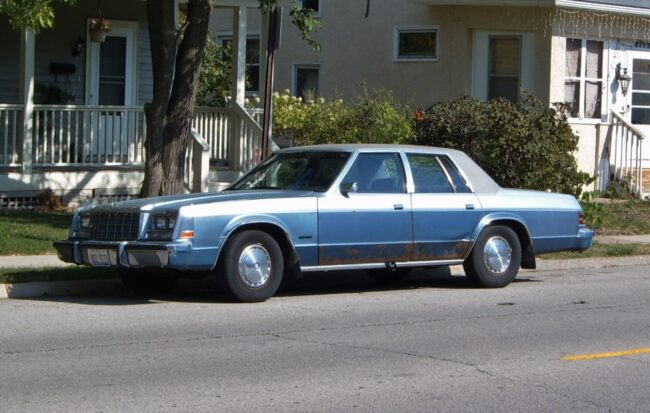
Despite the carryover underpinnings, the new 1979 Newport was rather attractive and modern-looking in the GM vein. The interior offered ample space, as did the 21.3-cu ft trunk. Buyers who wanted some eight-cylinder oomph could choose from optional 135-hp 318, 150-hp 360, or 195-hp 360 V-8s. Also on the option list was an available Open Road handling package, which included firm-feel power steering and suspension, wider wheels, a rear sway bar and HD shock absorbers. I’m guessing there weren’t many takers for it, since most of the Chrysler buyers shelling out $6,405 (for the Six; the 318-V8 model ran $6,720) were probably more interested in a smooth and cushy ride.

Interiors were typical Chrysler–plush. Both the standard bench and optional 60/40 split bench seats were offered with standard cloth-and-vinyl upholstery or optional full vinyl. Because the world had not yet entered the Gray-and-Beige-Interiors-Only era, you could get your interior in blue, green, cashmere, red or gray–or even done up in white vinyl with contrasting red, blue or green trim.
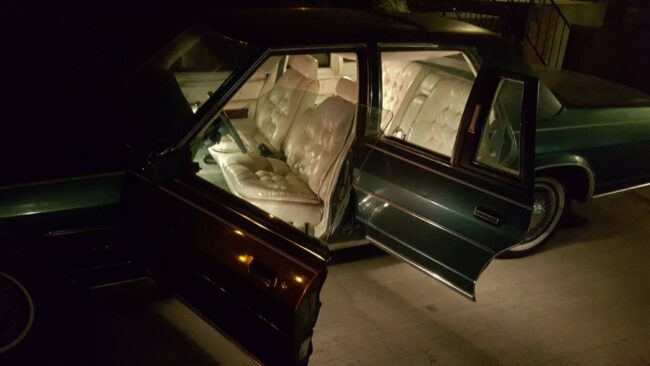
My friend Bobby Wicker has a ’79 with white leather and green trim. It’s Broughamtastic.
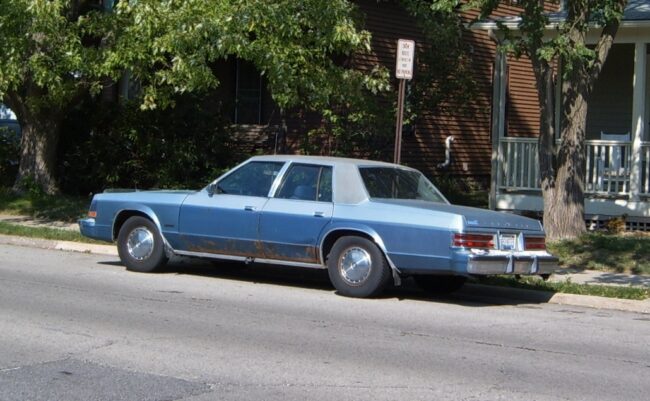
A four-door sedan was the sole body style. Apparently, Chrysler felt the LeBaron-based Town & Country was enough to fulfill the hauling needs of Mopar wagon buyers. With the Newport, Chrysler tried out some unique weight-saving features–including plastic brake cylinder pistons and lightweight aluminum bumpers. That led to trouble. The plastic brake parts failed after a couple of years, and the bumpers were not as sturdy as Mopar engineers had thought. Eventually, many an owner who’d whistled past Chrysler’s late ’70s cloud of doom to buy a ’79 Newport realized that purchasing a Caprice, Bonneville or Delta 88 might have been more prudent. Too late! *Dr. Evil laughter*
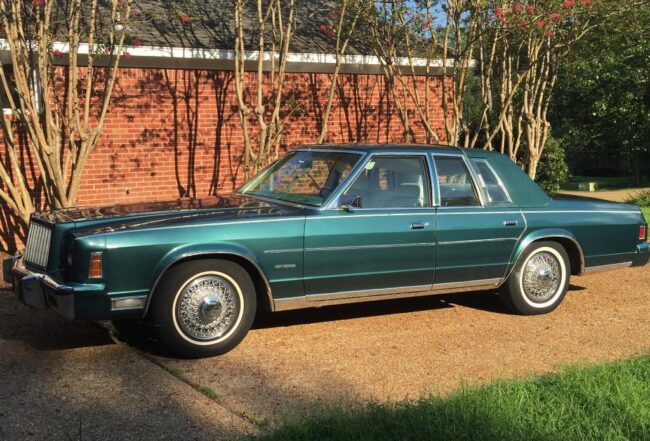
1979 New Yorker owned by Bobby Wicker
Initial sales of the Newport (and its New Yorker sibling) were fair enough. But the combination of Chrysler’s deteriorating financial condition and the 1979 gas crisis put big-car sales in the tank. In their first year of production, Chrysler moved 78,296 R-body Newports, many of which might have been fleet sales; there was no Plymouth equivalent yet, and in some cases the Newport actually cost less than Dodge’s St. Regis variant. Production of the $10,026, V8-engine New Yorker was lower, at 54,640 units, but it’s likely that most of those sales were to retail customers.
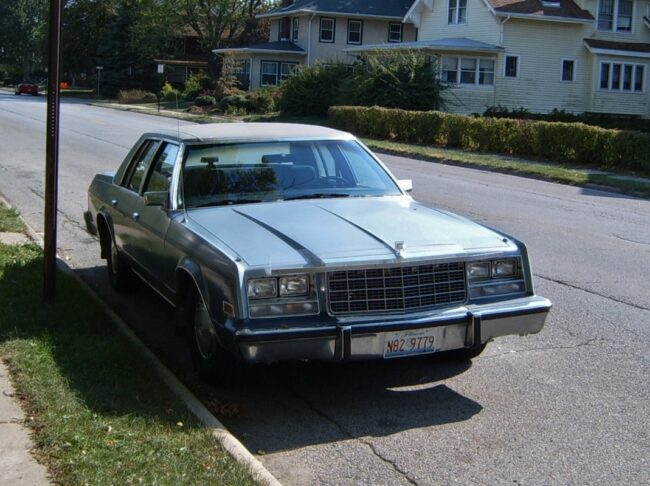
Nineteen seventy-nine would prove to be the high water mark for the R-body. A second energy crisis had hit in the spring of 1979, about halfway into the model year. Naturally, car sales took a major hit, and while every automaker felt the impact, it hit precariously-positioned Chrysler hardest. With barely a year on the job, its new boss, Lee Iacocca, hadn’t had a chance to address most of the company’s problems; at the time, all that mattered was regaining solvency and launching the new K-cars. As a result, Chrysler’s existing lineup would enter the next model year with the most minimal of changes. At Highland Park, 1979 was a rough year to say the least, with production down 15% from 1978, and a record $1.1 billion loss for the corporation.
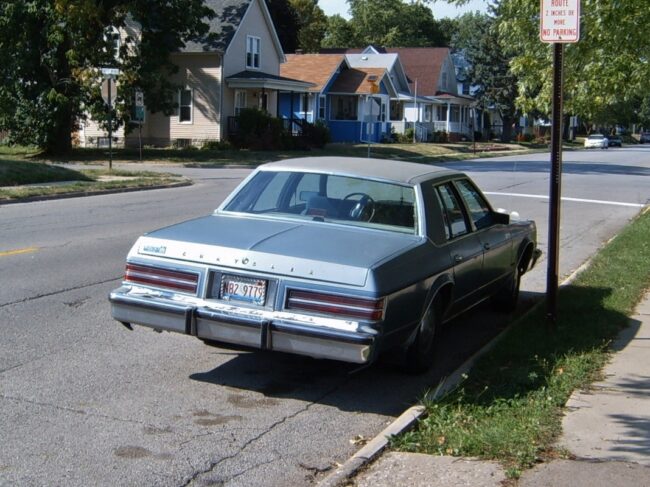
Back in 2012 I was working part-time hours at my insurance company job, and I found our featured two tone Newport while driving to lunch late that summer. I made a mental note to return later, but every time I got a chance to go back (usually around 1 PM), it was parked under a big tree, sitting in bright light and shadows that made for crappy photos. But a few weeks later I drove by around 3:00 PM, and the car wasn’t totally in the dark. Done deal.
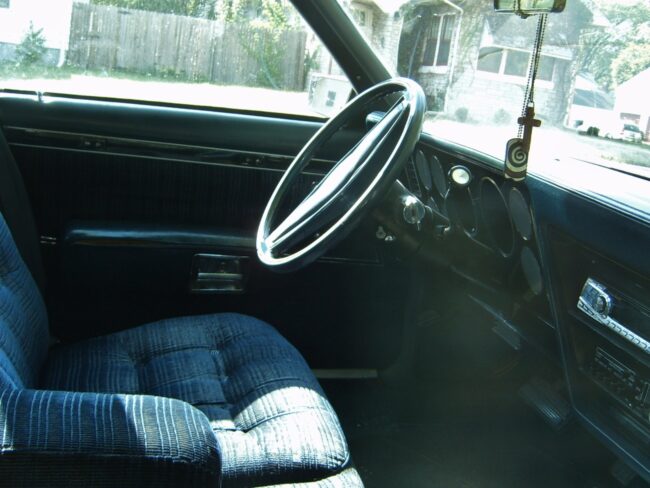
This car looked to be all original, from its two-tone Frost Blue-over-Ensign Blue paint to its midnight-blue cloth upholstery. The interior looks particularly cushy.
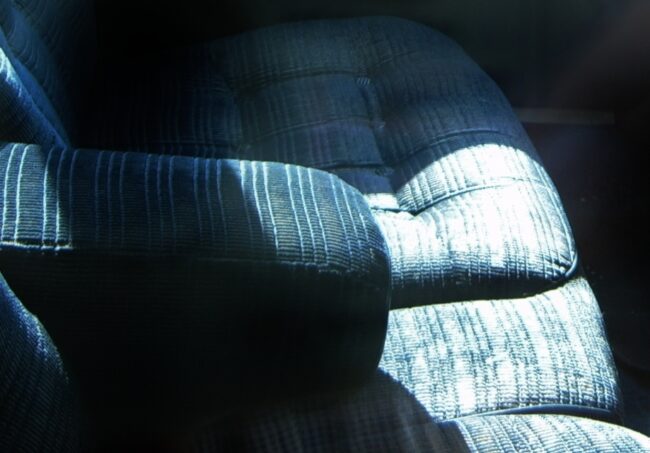
The driver’s side had a healthy crop of rust along the bottom, but for a then-33 year old car, it was pretty solid. Even in 2012 these were thin on the ground in the salty Midwest. I did see a light metallic blue 1979 New Yorker in nearby Silvis around 2013-14, but it was occupied at the time so I was unable to get any pictures. That’s the last one I’ve seen locally.
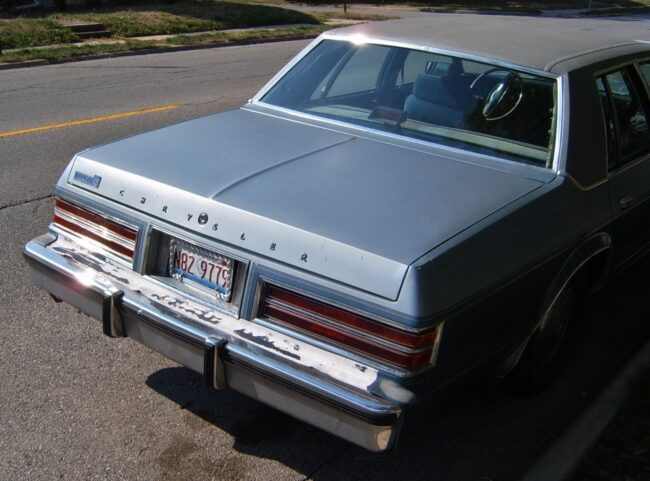
That vintage dealer tag came from a local Chrysler-Plymouth dealer, Kimberly C-P. They are still in business today, and in fact are right across from Strieter Lincoln, who takes care of my cars.

I can tell that this car is a first-year model by its distinctive 1979-only hood ornament, which features a stylized “C.” The Newport went largely unchanged throughout its short life, but 1980 models shared the corporate Pentastar hood ornament with K-cars, Caravans and many other ’80s Mopars.
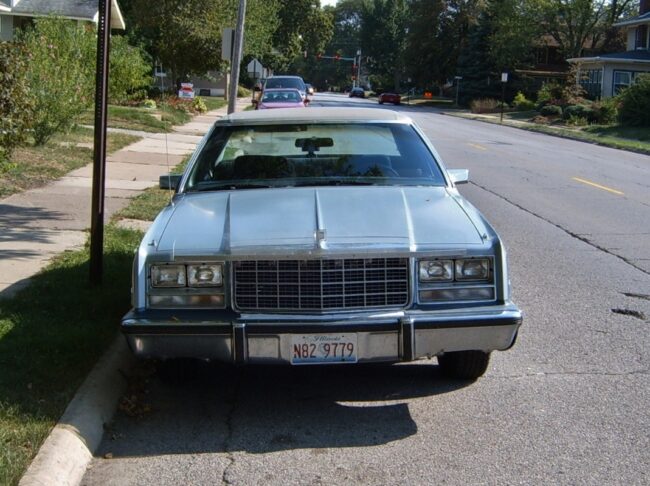
In side view, the R-body had a strong GM B-body vibe, but the front end looks more Chrysler-like. Still, it could pass for a C-body Buick Electra from a distance, especially the 1977 model-including the front end and grille. Another indicator of a longtime owner is that once-ubiquitous bug shield. Those things used to be everywhere! If all those bug shields were simultaneously thrown off of a cliff, I’d sleep just fine.
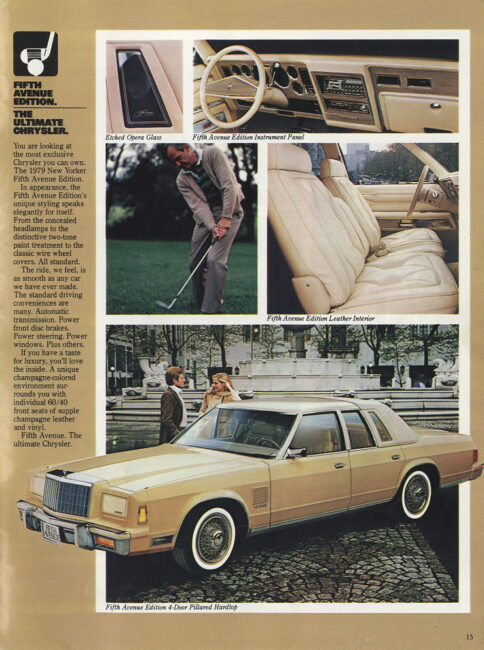
R-body production for 1979 was not up to expectations, but positively great compared with 1980; that year saw only 15,061 Newports and 13,513 New Yorkers come off the line. As you would expect with a recently redone model, changes were minimal.
One reason for the Newport’s sales drop might have been reintroduction of the Plymouth Gran Fury to satisfy Plymouth dealers, who’d not seen many police car sales since the ’78 Fury’s departure and demanded their own (and cheaper) R-body. I can’t really blame them, since at the time they offered only the Volare, Horizon, Trail Duster, some full-size vans and a bunch of captive imports.
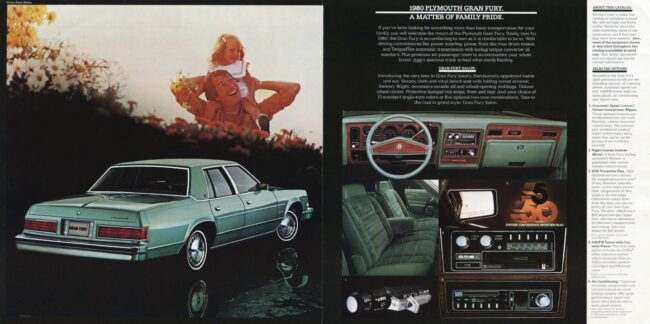
For the R-body, the arrival of the big Plymouth was too little, too late. Chrysler was betting the house on the K-car, and full-sizers like the R-body trio were not in Iacocca’s long-term plans. Despite the short model year. Both the Newport and the New Yorker got new grilles for a shortened 1981 model year, during which just 3,622 Newports and 6,548 New Yorkers were sold. Then it was over. It was the end of both the big Chrysler and the Newport name. Now, the midsize M-body LeBaron/New Yorker/Fifth Avenue would carry the V8 rear-drive torch for Chrysler–and, against all odds, do quite well.
The success of the M-body, which lasted to 1989; final-year models even got a driver’s side airbag-makes me wonder what might have happened had Iacocca seen fit to produce the R-body a few more years. After all, GM B-body sales also tanked (thought not quite so drastically) in 1980-81, and in 1982 Pontiac went so far as to eliminate full-size models. In time, sales picked up (as the dire prediction of soaring gas prices vaporized by around 1983). By the mid-eighties, Caprices, Delta 88s and LeSabres were selling in decent numbers once again. Even Pontiac brought back a full-sizer, the badge-engineered Canadian Parisienne, which lasted through the 1986 model year. Could Mopar have gotten in on that? Would it have made a difference?
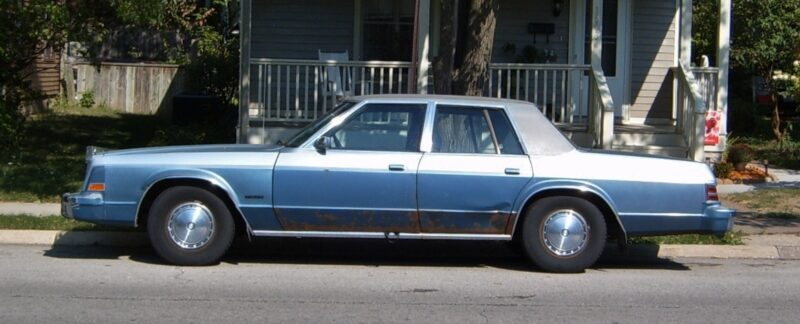

The 70s big Chrysler story is really one of bad timing. In 1974 a smaller, lighter full size like the 79 with a slant six would have been a distinctive offering in the aftermath of Yom Kippur. In 1979, with Iacocca gone at Ford and the company knuckling under to also abandon the really big Ford, a new Chrysler that got bigger and had some swagger like the 1974s would have really kept the big car flag flying and been an alternative to austere B bodies and early single headlight box panthers. With so much of their volume being VW engined Horizons there was even room for Chrysler to make such a move despite CAFE.
Bad timing as well as crushing regulations that disproportionately hurt the smaller players. I’ve read everything I can on the topic. Automakers had to comply with the new clean air regulations as well as CAFE and many Federal Motor Vehicle Safety Standards which were all new for the 70’s. So hostile was Congress to the automakers that they forbid them from working together on emissions technology (GM went after catalytic converters, Ford AIR pumps, Chrysler Lean Burn), forcing them to spend multiples in capital for non-value added content for the customer. It’s really no wonder the US automakers struggled with their products in the 70’s most of their engineering efforts were focused on regulatory actions.
I have heard the holy grail in R bodies is the Canadian market New Yorker with the 4 barrel 360. Canada had stuck with 1974 USA smog levels and so their 360 was at 230hp instead of 195hp.
The B-body started out in 1962 under the down-sized full-size Dodges and Plymouths that Chrysler had been fooled into creating for a market that didn’t want them. It was repurposed for successful use as the basis of a plethora of intermediates in 1965. Then it ended its days repurposed again for use as R-body downsized full-size cars to no great effect.
One technical feature discussed by the magazines when these cars came out was stamped aluminum wheels. They looked like steel wheels, but were stamped from sheets of an aluminum alloy. The result was wheels that weighed considerably less than stamped steel or cast aluminum wheels. It seems that unlike the brake cylinders and bumpers, problems with the wheels were discovered early enough to prevent them from ever reaching customers. At least I can find no evidence of the wheels being used, advertised, or recalled.
I know there isn’t an “Ask Tom” but what would you say is the sweet spot for something broughamtastic that could still be used as a DD? I don’t need leather seats, in fact I like velour, but if it it had leather it better not be rat-hide from China. I like those old school thrones and disdain and “euro” pretensions that boil down to a harsh ride. It also should be well sorted, reliable, and have cheap and abundant parts for when it does break down. I’m thinking an early 90’s Caddy model in the latter half of its life cycle. On the other hand I really like the Roller-esque grills of the early 80s Caddys, and I have a soft spot for Lincolns. Commute is generally sub-45mph in reasonable weather so safety is not a big concern. What say you?
My top 3:
1989-93 Sedan de Ville/Coupe de Ville/Fleetwood: Still see semi-regularly, about the perfect size, comfy, great glass area. But they require premium fuel.
1995-97 Town Car: Modern, but still pretty Broughamy, could still get burgundy, navy or even green leather. Yes, I owned a 2000 and still have the 2004, but I really loved the looks of the 1995-97 version, and that’s what I’d look for if I ever sold Big Rhonda.
1993-96 Fleetwood Brougham: Last of the really ‘Cadillacy’ Cadillacs, V8, RWD, and big. I recommend Calypso Green.
Honorable Mention: 1997-2005 Park Avenue: Pretty much bulletproof, but with the ’97 restyle the interior really was a downgrade from the 1991-96 Parks. Now that I think about it a 1991-96 Park Avenue would be nice too, also the 1992-99 LeSabres…
Tom,
My friend Dave just got in your next new car. I realize it is not in the year range you denote above, but this is a “new” car…. it is not even broke in yet, and it has a very Broughamy interior if you can get past the upscale T-Brid dashboard… 🙂
https://www.orlandoclassiccars.net/vehicles/653/1984-lincoln-town-car
Happy Motoring….
Nice, but I got a certified preowned domestic sedan back in August. 🙂
Orlando Classic Cars always has extremely nice cars! They had a triple white 77 or 78 Riviera last summer that was gorgeous.
That dealer has some cool stuff, but they are smoking their shorts with some of those prices. $45k for a grey on grey 1990 Caprice?
Well, where you gonna find another one?
I’m rather captivated by the green-on-green Bonnie coupe myself.
Ohhhh, that 1980 Corvette… It looks just like the one in the ads…
Bad timing was Chrysler’s calling card, mostly because they always followed what GM was doing. They downsized their 1962 full-sizers because they heard GM was going to do it, but it turned out GM downsized in 1961 by a miniscule amount and rode the full-size gravy train all through the 60s, while Chrysler drastically downsized and got burned. Then they replaced their relatively successful fuselage re-entry into full-size market with even larger full-sizers in 1974 in response to GM’s 1971 upsize, just in time for the first oil crisis and the tanking of full-size sales. Same thing in 1979 with these as they followed GM by 2 years and got hit by the second oil crisis. These timing problems were nearly fatal every time because the full-sizers were pretty much the only thing Chrysler could potentially make any profit on, since their smaller stuff was became more and more fleet oriented. A down-sized model that was 220 inches long just showed how crazy large Americans cars were by the mid-70s, but then again the best sellers (and responsible for 90% of Detroit profits) are now 240+ inch long pickups so the times they aren’t a changing – although Dylan in recent times has done Chrysler Super Bowl ads.
Does anybody recognize the building the 78 Newport is in front of? Most 1978 architecture is pretty dreary but this captures that late 70s southwest new energy money castle in the desert vibe.
When my brother graduated Cornell in 1980, the big fraternity drinking song had a lyric, we start at Exxon in the morn. By 2012, at my nephew’s graduation, it was we are going to occupy Wall street, at least they meant the jobs.
Typical Chrysler product of the era: poorly timed, poorly engineered, poorly built, and styled to look like a two year old Buick.
There’s a case to be made that the R-bodies were no worse than the early Panthers, which featured lousy assembly quality, a temperamental variable venturi carb, and, for 1980, the half-baked AOD transmission. It was widely reported around ’82/’83 that Ford was going to follow suit and discontinue the Panther cars, with the Fox LTD/Marquis/Continental and eventually the Taurus/Sable being their intended replacements. That never happened as sales of the big cars (especially the Town Car) rebounded.
The whataboutism over what could have happened if Chrysler had hung on with the R-body a bit longer seems pretty moot though. Cancelling those cars was the rational choice given the abysmal sales picture in ’80/’81. Even if the cars had been perfectly executed, they likely still would have flopped given Chrysler’s reputation and the economic state. The K-car and Omnirizon were the future while everything else was dead in the water. The stopgap M-body New Yorker/Fifth Avenue ended up being a surprise hit to the extent that Chrysler had to farm out production to AMC. The K-based New Yorker Turbo, as laughable as it is now, was also a decent seller and the two models combined performed about as well as the big Newport/New Yorker ever did. It’s doubtful keeping the R instead would have moved the needle much – if anything it probably would have done worse due to its added size and weight.
The most interesting thing about these cars was that Plymouth didn’t get a version from the start. Plymouth had been third in sales as recently as 1974 and always outsold Dodge until ’79 when the brand started getting denied a full lineup. To some extent, it made sense to kneecap Plymouth in order to boost more lucrative Chrysler volume on the same showroom floor, but at the same time, everything from Newport cop cars to PT Cruisers steadily eroded whatever premium value the Chrysler brand had.
I have to agree with your assessment of the situation in the late 1970’s. We all were told that gasoline would be $4 gallon by 1985 and the FWD transverse engine cars were the future. Whether it was by consumer demand or governmental decree, we got FWD cars and we liked it. Generally. You’re also correct about Chrysler’s reputation at the time. In 1978, one of my brothers was looking for a new car, we even looked at a 024 Omni and he liked it a lot, but was afraid that Chrysler wouldn’t exist by 1979. So he bought a Ford Fairmont instead. I can remember Chrysler being compared to Studebaker. In 1980, my other brother was looking for a new car, but he took the plunge and bought a Dodge… Colt. But I think by the time he bought the Colt, the loan guarantees had been announced, so it was bit more likely that someone would be able to service the car.
I may have told you this before, but my FIL had a 1980 (IIRC) New Yorker. The company he worked for was a Chrysler supplier, they got a discount of course. While it was a super nicely appointed car, rode and drove well, it was a reliability disaster. Not well assembled and had various issues with the engine (Lean Burn). I liked the car a great deal, but according to him it was a turd. It was replaced with a Dodge Mirada the next year, while better assembled, it was horribly underpowered, at least according to my FIL. OTOH, all of the cars he owned up until the late 70’s were big V8’s. As an example, his daughter’s (now my wife) first car was a 455 Toronado…
About three years ago I ran across a green on green with white vinyl landau roof 1979 Chrysler New Yorker for sale. It was a true survivor, it even still had the the Tuff-Kote sticker in the rear window. It was largely clean, but you could tell it had been hit in the rear hard enough to compress the bumper to the rear valance panel and crack some of the trim around the tail lights. Listed at 60K + miles and for $6K, but you could see that the price had been taped over and a (I guess) a lower price pasted in place. In retrospect, I should have gotten it and found a place to stash it, but I really couldn’t make it work. I have no idea if it sold, but someone got a real nice time capsule.